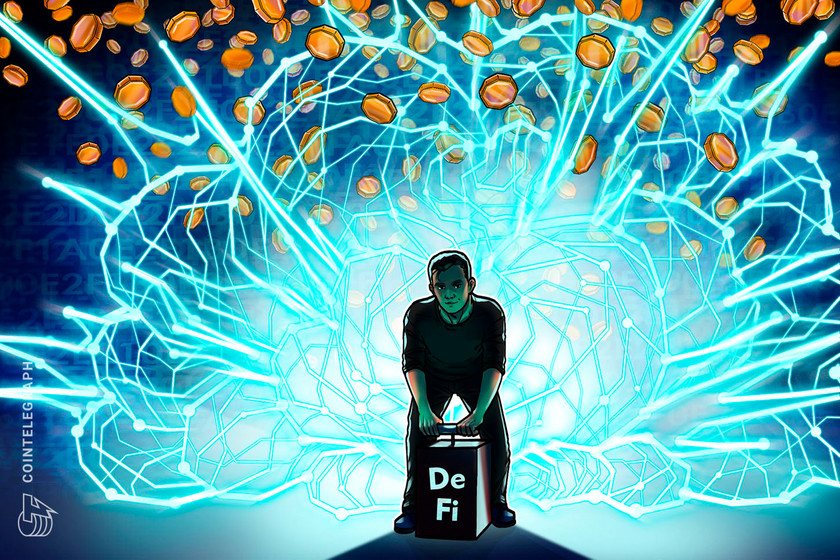3 key reasons why the DeFi sector is booming again

Mergers between sector leaders, rising TVL, and traders looking for fast returns are the primary factors behind the current DeFi boom.
Data from Messari shows that over the past 30 days, the majority of tokens listed on the site’s DeFi Assets index have rallied by more than 20%. A few standouts such as Maker’s MKR, Synthetic Network Token (SNX) and SushiSwap’s SUSHI gained more than 100% during the same time frame.

From Jan. 1 to Jan. 9, the decentralized finance sector saw its total value locked (TVL) rise from $15.678 billion to a record-high $23.092 billion, and this recovery to a new all-time high came about four months after the DeFi bull market abruptly came to an end.
Now that Bitcoin (BTC) and Ether (ETH) have rallied to multiyear highs, investors are again turning their attention to the DeFi sector, and it’s likely that the start of a new bull market, soaring TVL in the top DeFi platforms, and the steady integration of Ethereum alternatives are the primary reasons for the current surge.
Bitcoin and Ethereum carry the market higher
The last few months of bullish price action from Bitcoin and Ether are undoubtedly having a positive effect on the entire cryptocurrency market. Currently, the combined market capitalizatio of the top two digital assets is more than $850 billion, comprising 80% of the total value of the cryptocurrency market.
As the prices of the top cryptocurrencies rise, some investors look for ways to maximize their profits, and the high staking yields and four-digit investment returns offered by many of the small-cap tokens have proven to be an irresistible lure to traders.
Historical data shows that when Bitcoin and Ether prices are rallying, altcoins tend to follow, and when Bitcoin consolidates in a “predictable” range, altcoins and DeFi tokens usually rally. This market dynamic could partially explain the recent surge in DeFi tokens.
Total value locked is on the rise
Data from DeFi Pulse shows that the total value locked across DeFi protocols has increased from $15.36 billion to $22.74 billion over the past 10 days. This sharp increase in TVL coincides with Bitcoin’s rally from $29,000 to its $41,950 all-time high, and during the same time, Ether’s price also rose from $740 to $1,300.

A number of high-profile partnerships and mergers between some of the top-ranked DeFi protocols are also attracting new funds to the sector. In early December 2020, Yearn.finance and SushiSwap, two of the top DeFi projects, announced a merger that saw the protocols develop resources and integrate their liquidity pools to increase the total value locked.
Developments like this help to create a safer, more efficient user experience for members of the community and, in this instance, helped lead to a rise in YFI price from $18,255 at the beginning of Nov. 26, 2020 to the Jan. 9 swing high at $39,990, an increase of 118%
Increasing DEX volume
Volume and transactions are key metrics used when evaluating the value of a DeFi project and the strength of its community. One way to determine this is to look at the daily volume of a project’s decentralized exchange (DEX) to get a picture of how much value is transacted on the protocol during a particular time frame.

Since the start of 2020, the daily DEX volume for the top-ranked DeFi projects has more than doubled from $900 million on Jan.1 to a peak of $2.4 billion on Jan. 4, indicating a significant increase in user activity. This suggests that traders took advantage of the bull market conditions that much of the cryptocurrency market was experiencing during that time.
With Ethereum 2.0 still rolling out, a critical issue to monitor during any DeFi boom is Etheruem gas fees and transaction speeds. Messari data also shows that DeFi tokens focused on layer-two solutions rallied strongly as developers searched for ways to successfully integrate faster, lower-fee off-chain options that can work as alternatives to Etheruem.
As reported by Cointelegraph, tokens like Solana‘s SOL, Loopring’s LRC, Matic and THORChain‘s RUNE have all rallied as developers continue to search for and experiment with layer-two options.



